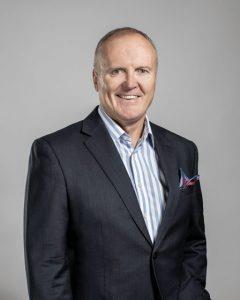
Formed in April 2020, Partners& was created by bringing together four quality insurance brokers to offer improved risk management capabilities, insurance broking and employee benefits expertise, to become what it describes itself as a “next generation” insurance adviser.
The business is led by CEO Phil Barton, pictured, who has worked in the insurance and financial services sector for almost 40 years, including leadership roles with the likes of Jelf, part of Marsh McClennan, the largest insurance broker in the world, while John Marks is client partner specialising in providing bespoke solutions for the haulage and logistics industry. He has been in the insurance industry providing specialist solutions for the industry for nearly 40 years, working at Jelf for 13 years and with John Lampier & Son for 25 years.

Apart from the breadth of its services and the depth of its experience, the other aspect that sets Partners& apart from other commercial insurance brokers is that it provides full advisory services to its clients, rather than simply selling insurance in a transactional way as a broker focused on price alone.
“After 38 years in financial services, my view was that it was not serving its clients well enough,” says Barton. “Never has that been better illustrated than through Covid-19. If the pandemic has taught the industry anything, it is that clients were largely unaware of the risks they were exposed to and did not truly understand what they had bought. Hence why there was so much confusion over business interruption cover.”
In January 2021 the UK Supreme Court ruled in favour of thousands of policyholders and against the insurers who had argued that business interruption (BI) policies did not cover the effects of Covid-19 and the consequent government lockdowns.
“People thought they had bought BI cover, but didn’t really understand the wording of their policies,” says Barton. “My view is that, in general, the industry has not been serving clients well. Material claims, with the propensity to impact clients’ business plans, typically take three years to settle, often go to litigation, and when they are settled clients typically only receive 60% of the potential indemnity they might have expected.
“If the industry were a car manufacturer, one in two of the cars rolling off the production line wouldn’t work. That is not good enough. So I decided to walk away from these practices and create a business that sets a new benchmark for providing advice.”
Not about numbers
Barton argues that insurance brokers have become too focused on commoditising insurance, stripping out cost and competing on price alone. When combined with the race for scale amongst brokers, the client seemingly has been forgotten. But Partners& takes a different approach. “We are committed to challenging that, and creating a better outcome for clients,” he says. “We are more interested in risk protection advice and resolving the client’s broader issues, seeing ourselves as advisers covering the wider risk issues that our clients face and getting the advice right at the outset.
“Interestingly the insurance companies are absolutely aligned to our approach. The large brokers have been able to leverage their scale with insurers, so value has migrated from the insurer to the broker and the insurers’ margins have narrowed.
“When scale is over-rewarded, capital comes to the market with the sole intent of scaling, which encourages M&A. These big brokers then seek to cut costs, reduce their claims offering, diminish their risk management service and provide remote advice via call centres in order to make sense of their financial models.”

John Marks, pictured, goes on: “If you look at the motor risk, which is normally the largest risk protection purchase for a haulage and logistics business, the underwriters [who decide if applications for cover should be accepted and on what terms ] have had their authority reduced and are working within much smaller parameters because actuaries [who analyse financial risk using mathematical and statistical models] are running the numbers.
“We are seeing underwriters saying ‘Sorry, this is all I can do’. So the market has reduced, though who is in and who is out constantly changes. We are now back to a bespoke approach and simply sending detail to numerous underwriters is not going to get the desired result.
“The market has contracted, but we are now starting to see some who weren’t in the game coming back. Knowing the underwriters well is really key.”
Different insurers will also take on different risks, and a typical owner-managed haulage business could have 10 risks covered, each of which could be with a different insurer. “For me, every solution is bespoke,” says Marks. “It is what is right for the client every single time.”
When looking for an insurer to take on a particular risk, really understanding the client’s business and operation by carrying out a thorough investigation and presenting all the facts “warts and all” is vital.
“The more knowledge and information we can give an underwriter – including what the client isn’t doing well or what has gone wrong – the better,” says Marks. “They will then trust us and know over a period of time that the information we give them is all there and they can underwrite the risk knowing exactly what it is. Fair presentation of any risk is a key part of the adviser’s role.”
Breaking the internet
A growing element in risk management for every business is cybersecurity and here insurers want a lot of information about the measures operators are taking to stop the hackers and recover in the event of an attack.
“We can provide clients with a bespoke report that compares them to their peers and tells them where their risks sit in red, amber and green bands,” explains Marks. “That enables them to very quickly identify the risks and consider either purchasing protection or accepting them. That is then a truly informed decision.”
Barton argues this is the “fundamental role” of a risk management adviser. He says: “We see it as our role to help the client understand the risks and present them accurately and holistically to the market. The rest of the market has failed to do that consistently.”
While fitting telematics to vehicles to monitor driver behaviour has been claimed to reduce insurance premiums, Marks says it is in fact only when telematics and driver training has been shown to drive down accident rates that insurers will cut premiums.
“A lot of telematics companies were saying ‘You will get a reduction in your premium’, but the truth is that in a decent size fleet that isn’t going to happen,” he says. “The numbers still drive the premium. You can have all the telematics, but if the drivers are still having accidents, then your premium is going to increase.
“The other issue is that if you have telematics data for your drivers and do nothing with it, you could be culpable. The data might be telling you that a driver is likely to have an accident because he has lots of harsh braking and is speeding. But if you just file it away and then he has a bad crash, it is clear it was coming and you did nothing about it.
“Telematics is very good for risk management, but it won’t solve the problem unless you use the data. I often advise transport company MDs ‘If you’ve got the data, give it to someone to look at and do the work’. Even if it’s only the worst five, get them in, highlight why they are top of the list, and explain that it is not acceptable and give advice and training to help them improve.
“That will go round the yard like wildfire and the culture will start to embed that the company will not put up with sub-standard driving but are willing to work with the driver to help improve performance.”
The problem is that the driver shortages mean transport managers might not be able to dismiss drivers due to poor driving as there is no one to replace them. But if this approach leads to more accidents, then the company – and industry – will pay in the form of higher premiums.
“A lot of insurers I’m talking to are talking about rate hikes already,” says Marks. “And even for those companies with a reasonable claims experience, insurers are looking for rate increases. Good risk management is key and we want to support the industry by giving bespoke and relevant advice to help reduce the risks and therefore claims, and ultimately premiums.”
While no one is saying agency drivers are necessarily any worse than those on the payroll, the increased risk they pose has been on the insurance companies’ radar for a number of years. “There is a specific question now on every insurance company proposal form asking ‘Do you use agency drivers and if so what percentage of your staff is agency?’ Those with high agency use tend to have more claims. If an operator is using 25% agency, that is much higher risk than someone with 2%,” he says.
- Partners&, the specialist in business and private client insurance, employee benefits and risk management, has become the Motor Transport Awards partner for the Partnership Award.
Convincing insurers to cover young drivers
An increasingly important risk factor for operators is the driver shortage crisis and the policies operators need to put in place to recruit and retain drivers by looking after and motivating them is an area Partners& is able to advise on.
“The recruitment market has become a lot tighter, but most of our competitors completely ignore that perspective,” says Barton. “Everyone focuses on the wheels and cargo, but this is an aspect the adviser should be considering if he or she is doing a complete job for the client.”

Those operators looking to recruit and train young people however often meet resistance from insurers unwilling to cover HGV drivers under 21, despite evidence that well-trained younger drivers can outperform their more experienced counterparts.
“Drivers aged 18 to 21 are an exception and a lot of the London market looks for drivers age 25 to 65 with two years’ experience,” acknowledges Marks. “This is something I’m challenging because I understand the industry and I’m saying to insurers ‘We have a problem, there aren‘t enough drivers’ and even if a 19- or 20-year-old puts himself through his Class 1, he can’t get a job because no one will insure him. That is very unfair.
“We are doing some investigatory work in the training world with hauliers wanting to employ young drivers to find out what support, grants and additional incentives are available. We can then go to the insurers to say ‘They are doing it properly and you have to let operators with a trusted process make the decision on whether they want to put that risk on their policy’. Yes, there will be an excess, but we need the insurance industry to help the operators out of this mess.
“We are passionate about the haulage and logistics industry and want to provide real support and advice to help improve the risk and reduce the cost of risk protection.”














